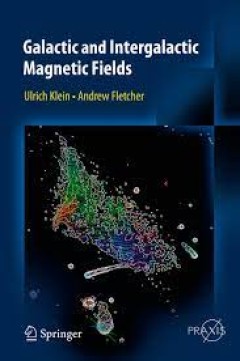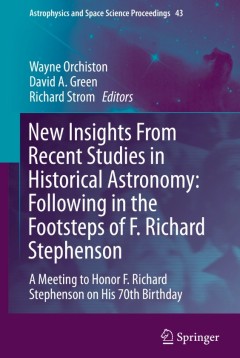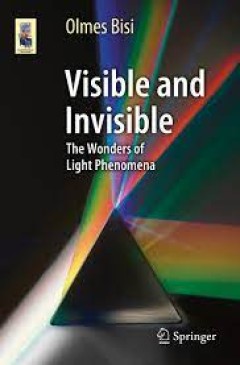Filter by

Galactic and Intergalactic Magnetic Fields
This course-tested textbook conveys the fundamentals of magnetic fields and relativistic plasma in diffuse cosmic media, with a primary focus on phenomena that have been observed at different wavelengths. Theoretical concepts are addressed wherever necessary, with derivations presented in sufficient detail to be generally accessible. In the first few chapters the authors present an introductio…
- Edition
- -
- ISBN/ISSN
- 978-3-319-08942-3
- Collation
- -
- Series Title
- -
- Call Number
- -

Galactic Encounters Our Majestic and Evolving Star-System, From the Big Bang…
Written by William Sheehan, a noted historian of astronomy, and Christopher J. Conselice, a professional astronomer specializing in galaxies in the early universe, this book tells the story of how astronomers have pieced together what is known about the vast and complicated systems of stars and dust known as galaxies. The first galaxies appeared as violently disturbed exotic objects when the…
- Edition
- -
- ISBN/ISSN
- 978-0-387-85347-5
- Collation
- -
- Series Title
- -
- Call Number
- -

New Insights From Recent Studies in Historical Astronomy: Following in the Fo…
This book contains papers from a conference held to celebrate the 70th birthday of one of the world’s foremost astronomical historians, Professor F. Richard Stephenson, the latest recipient of the American Astronomical Society’s highest award for research in astronomical history, the LeRoy Doggett Prize. Reflecting Professor Stephenson’s extensive research portfolio, this book brings toge…
- Edition
- 1
- ISBN/ISSN
- 978-3-319-07613-3
- Collation
- XXX, 350
- Series Title
- Astrophysics and Space Science Proceedings
- Call Number
- -

Astrophysics Is Easy! An Introduction for the Amateur Astronomer
Astrophysics is often –with some justification – regarded as incomprehensible without the use of higher mathematics. Consequently, many amateur astronomers miss out on some of the most fascinating aspects of the subject. Astrophysics Is Easy! cuts through the difficult mathematics and explains the basics of astrophysics in accessible terms. Using nothing more than plain arithmetic and simpl…
- Edition
- -
- ISBN/ISSN
- 978-3-319-11644-0
- Collation
- -
- Series Title
- -
- Call Number
- -

Astrophotography on the Go Using Short Exposures with Light Mounts
No longer are heavy, sturdy, expensive mounts and tripods required to photograph deep space. With today's advances in technology, all that is required is an entry-DSLR and an entry level GoTo telescope. Here is all of the information needed to start photographing the night sky without buying expensive tracking mounts. By using multiple short exposures and combining them with mostly ‘freeware�…
- Edition
- -
- ISBN/ISSN
- 978-3-319-09831-9
- Collation
- -
- Series Title
- -
- Call Number
- -

Worlds Beyond Our Own The Search for Habitable Planets
This is a book on planets: Solar system planets and dwarf planets. And planets outside our solar system – exoplanets. How did they form? What types of planets are there and what do they have in common? How do they differ? What do we know about their atmospheres – if they have one? What are the conditions for life and on which planets may they be met? And what’s the origin of life on Earth…
- Edition
- -
- ISBN/ISSN
- 978-3-319-09894-4
- Collation
- -
- Series Title
- -
- Call Number
- -

What If We Don't Die? The Morality of Immortality
This book deals with the very real possibility of earthly immortality and the human and societal implications of such immortality, including whether it is desirable. It looks at what makes immortality appear so attractive and at the possibility that we would be better served with longer lives and the freedom to terminate our lives at the time when life has given us all the joy, inspiration a…
- Edition
- -
- ISBN/ISSN
- 978-3-319-19093-8
- Collation
- VIII, 183
- Series Title
- -
- Call Number
- -

Weird Universe Exploring the Most Bizarre Ideas in Cosmology
As new discoveries complicate the scientific picture of the universe, the evolving theories about the nature of space and time and the origins and fate of the universe threaten to become overwhelming. Enter David Seargent. Continuing the author's series of books popularizing strange astronomy facts and knowledge, Weird Universe explains the bizarre, complicated terrain of modern cosmology for l…
- Edition
- -
- ISBN/ISSN
- 978-3-319-10738-7
- Collation
- XV, 272
- Series Title
- -
- Call Number
- -

Alpha Centauri: Unveiling the Secrets of Our Nearest Stellar Neighbor
As our closest stellar companion and composed of two Sun-like stars and a third small dwarf star, Alpha Centauri is an ideal testing ground of astrophysical models and has played a central role in the history and development of modern astronomy—from the first guesses at stellar distances to understanding how our own star, the Sun, might have evolved. It is also the host of the nearest known e…
- Edition
- Ed. 1
- ISBN/ISSN
- 978-3-319-09372-7
- Collation
- XXIII, 297
- Series Title
- Astronomers' Universe
- Call Number
- 520 BEE a

Visible and Invisible The Wonders of Light Phenomena
Light phenomena have intrigued humankind since prehistory. Think of the rainbow, a sunset on the sea, a game of shadows. Humans have always used light for their own needs, from cooking food to illuminating a room. However, light is not only limited to what we can see with our eyes. The invisible part of the electromagnetic spectrum is broad and dynamic. This book outlines the mysteries and w…
- Edition
- -
- ISBN/ISSN
- 978-3-319-09825-8
- Collation
- XXI, 314
- Series Title
- -
- Call Number
- -
 Computer Science, Information & General Works
Computer Science, Information & General Works  Philosophy & Psychology
Philosophy & Psychology  Religion
Religion  Social Sciences
Social Sciences  Language
Language  Pure Science
Pure Science  Applied Sciences
Applied Sciences  Art & Recreation
Art & Recreation  Literature
Literature  History & Geography
History & Geography